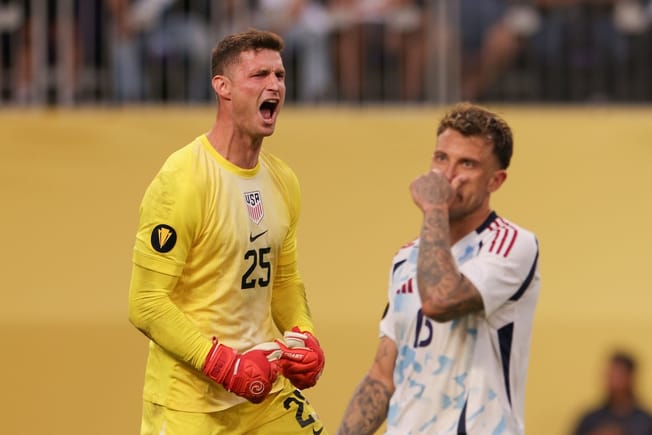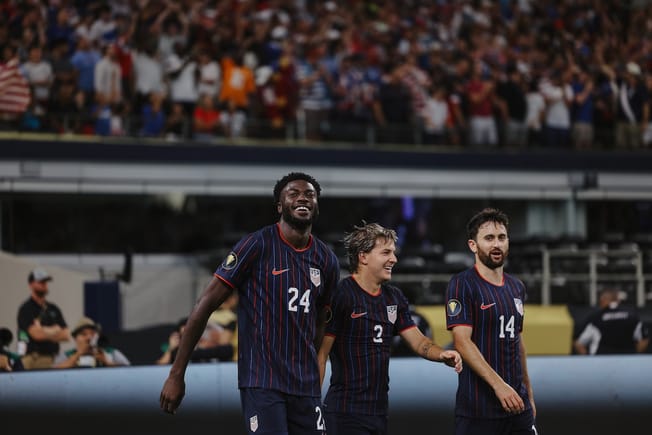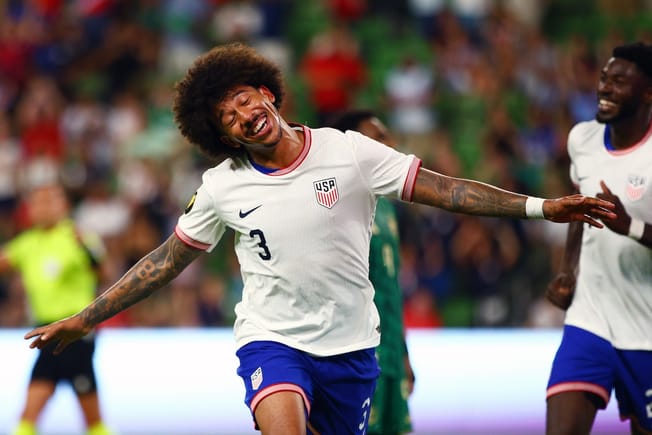Quick Hits
- While the United States get ready to kick off their 2022 World Cup campaign, we’re thinking back to the 2018 World Cup…when the U.S. watched the tournament from home
- Today, we’re looking back to the USMNT’s loss to Trinidad and Tobago in 2017 to analyze how the team has changed since that historic failure
“Couva” is a word that makes every United States men’s national team fan shudder. It was a game that resulted in the unthinkable: the United States missing out on the 2018 World Cup.
On October 10, 2017, the U.S went to their game against Trinidad and Tobago in Couva, a city on the west side of Trinidad, knowing that a win would get them into the World Cup and a tie would likely do the same. But instead of stepping up to beat a team that had only bested them twice in the previous 35 years, the United States didn’t show up. They allowed two soft goals and lost the game 2-1. All of a sudden, one of Concacaf’s giants was going to watch the World Cup at home on TV for the first time since 1986.
The most upsetting thing for the U.S. was that the failure to qualify for the 2018 World Cup wasn’t just tied to this single loss, but came at the end of a cascade of failures.
But fortunately, the USMNT qualified for the 2022 World Cup – the one that kicks off in less than a week. Ahead of the group stage, we’re breaking down four key moments from that dreaded game in Couva and analyzing what they said about U.S. Soccer at the time. We’re also looking at the ways current U.S. manager Gregg Berhalter has addressed those failures during his time in charge.
Let’s get to it.

17TH MINUTE: OMAR GONZALEZ SCORES AN OWN GOAL
🇹🇹GOOOOAAAAL🇹🇹
— beIN SPORTS USA (@beINSPORTSUSA) October 11, 2017
Omar, WYD?! #TRIvsUSA pic.twitter.com/MjV03LIH3y
What Happened:
Trinidad and Tobago’s Alvin Jones progressed the ball easily up the right side of the attack. After left back Jorge Villafana failed to provide enough pressure, Jones played a dangerous ball into the box. Center back Omar Gonzalez beat two Trinidadian attackers to the cross, but awkwardly deflected the ball into the net and past Tim Howard.
What It Said About the Old Era:
When you look at the lineup for the Couva game, one of the big missing pieces for the United States was center back John Brooks who tore his thigh that August, 2017 in his debut for Wolfsburg. The 24-year-old looked like he was going to anchor the U.S. backline for the next decade. Without Brooks, Bruce Arena went with veterans Gonzalez and Matt Besler to solidify the backline.
Tactically, defensive passivity was a major issue for the United States during the 2018 World Cup qualifying cycle. The U.S. seemed very willing to play with a deeper defensive line and simply absorb pressure. That, of course, means that you have to be willing to have your defenders make more plays on the ball in the box, and when they make a gaffe like Gonzalez did, it can lead to disaster.
After the U.S. bombed out of qualifying, it was apparent that the backline needed a make-over in terms of personnel and tactics. Besler never played for the U.S. again and Gonzalez stopped getting call-ups in 2019.
What Has Berhalter Done?
One of Berhalter’s biggest tactical changes has been switching to a much higher defensive line than the ones that Arena or Jurgen Klinsmann used. The U.S. now applies more pressure defensively than what we saw against Trinidad and Tobago.
According to Berhalter, this change is what has banished Brooks from the USMNT as the 29-year-old doesn’t fit the “game model” anymore.
Without Brooks, there will continue to be major question marks for the United States at center back, especially after Miles Robinson ruptured his Achilles tendon this spring after starting 11 of 14 World Cup qualifying games this cycle. The next generation of young center backs that was supposed to develop after Couva – Matt Miazga, Cameron Carter-Vickers, Erik Palmer-Brown, and Chris Richards – are yet to stake a claim to a regular USMNT starting spot.
37TH MINUTE: ALVIN JONES SCORES A GOLAZO
🇹🇹🚀GOOOOAAAAL🚀🇹🇹
— beIN SPORTS USA (@beINSPORTSUSA) October 11, 2017
Alvin Jones fires one off from Tobago, and #USMNT are down 2-0! #TRIvsUSA pic.twitter.com/S5f6Qa6GyS
What Happened:
Jones once again found acres of space on the right side after a switch of play. When no American stepped up defensively, Jones unleashed a 35-yard bomb that knuckled its way outside of Howard’s fully extended wingspan just inside the far post.
What It Said About the Old Era:
Passive defending wasn’t just an issue that affected the backline – the U.S.’s diamond midfield lacked a lot of bite in Couva, too. Paul Arriola is more of a winger than a No. 8, while Michael Bradley (don’t get me started about Klinnsmann playing Bradley as a No. 10) and Darlington Nagbe were primarily known for their ability on the ball as deep-lying playmakers.
Obviously, this goal from Jones was a one-in-a-million shot, but to watch Bradley and Nagbe jogging without any urgency in a high-profile game was brutal. On top of that, you have the entire backline sitting on the edge of the 18-yard box. It’s tough to watch, especially after the U.S. gave up a soft goal to open the game.
What Has Berhalter Done?
Berhalter has designed his 4-3-3 midfield around Tyler Adams in the single pivot. Adams isn’t the best on the ball, but his ability to act as a destroyer and shield the U.S.’s backline is unmatched in the player pool. Now, this could be problematic for the U.S. given there’s no like-for-like substitute who can do the same amount of defensive work that Adams delivers for the United States.
Alongside Adams, dual No. 8s Yunus Musah and Weston McKennie have become de facto starters when they are healthy. Both are terrific progressors of the ball and can also cover a great deal of ground on the defensive end. This new generation of U.S. midfielders represents a huge talent upgrade compared to what we saw on the field in Couva. The MMA midfield was a popular pick in Backheeled’s expert roundtable as the USMNT’s biggest strength.
47TH MINUTE: CHRISTIAN PULISIC SCORES
🇺🇸GOOOOAAAAL🇺🇸
— beIN SPORTS USA (@beINSPORTSUSA) October 11, 2017
It's the kid, AGAIN! @cpulisic_10 out here looking like Mes...a promising young prospect! #TRIvsUSA pic.twitter.com/99n0vlxO9f
What Happened:
Down two goals, US desperation was increasing. Nagbe wound up on his posterior after taking a shot from outside the box that was blocked by Jones of all people, but he corralled the loose ball and shuffled a pass over to Pulisic. Pulisic took a touch into space and stepped firmly into the ball to generate power on the shot. The combination of speed and a slight deflection off a Trinidadian defender saw Pulisic’s shot hit the back of the net.
What It Said About the Old Era:
One of the most disappointing things about the qualifying disaster was that Pulisic didn’t get to play in the 2018 World Cup.
Russia 2018 was a missed developmental opportunity for the then-19-year-old wunderkind playing for Dortmund. Before MLS academies really started pumping out high-level prospects, Pulisic seemed like a once-in-a-generation talent who would be the focal point of the U.S. attack for years to come. Arena for the Couva game played Pulisic at the No. 10 spot at the tip of the diamond, which was the best tactical decision he made that day.
What Has Berhalter Done?
With the rise of the McKennie, Musah, and Adams central midfield trio and the switch to the 4-3-3 under Berhalter, Pulisic has transitioned to a role on the left wing.
Playing on the wing gives Pulisic the ability to do what he does best: isolate and run at defenders in transition. However, in possession, Pulisic tends to drift inside like a No. 10 which forces the U.S. to depend on the fullback as the sole provider width on the left side. When left-footed Antonee Robinson is the fullback, that works just fine. But if Robinson isn’t on the field, right-footed Sergino Dest and Joe Scally are the next players on the left back depth chart. That could make providing width on the left at the wing position even more important.
77TH MINUTE: CLINT DEMPSEY’S SHOT HITS THE POST
😱 @clint_dempsey off the post! @ussoccer still looking for a late equalizer. #TRIvsUSA pic.twitter.com/WkrBRXVUAP
— beIN SPORTS USA (@beINSPORTSUSA) October 11, 2017
What Happened:
Arena subbed on the 34-year-old Clint Dempsey and shifted to a three-striker formation with Jozy Altidore and Bobby Wood. After Pulisic’s goal pulled the U.S. within one, the U.S.’s best attempt to equalize came from Dempsey when the Texan’s long-range shot hit the right post.
What It Said About the Old Era:
This game in Couva was not only the last cap in Dempsey’s legendary USMNT career where he had scored in three consecutive World Cups (2006, 2010, 2014). But if he had scored, he would have broken a tie with Landon Donovan on top of the USMNT all-time scoring leaderboard.
With Dempsey entering his twilight years, one of the big unanswered questions before the match against Trinidad and Tobago was who would replace him at striker in the U.S.’s attack. The strike pair of Altidore and Wood only scored a combined two goals after this game in Couva, so one of the most important tasks for Berhalter was to find a new striker to replace Dempsey.
What Has Berhalter Done?
Striker is still the biggest question mark out of Berhalter’s position groups entering the World Cup.
Berhalter started his tenure with a heavy dose of Gyasi Zardes in 2019, before trying a wide range of options like Daryl Dike, Nicholas Gioacchini, Jordan Pefok, Ayo Akinola, and Ricardo Pepi before settling on the triumvirate of Jesus Ferreira, Josh Sargent, and Haji Wright for the World Cup. While there is no elite option, the pool is deeper for Berhalter than it was in the 2018 World Cup qualifying cycle where Dom Dwyer, CJ Sapong, Terrence Boyd, and Chris Wondolowski get call-ups.
How the strikers work in Berhalter’s system is much different than the traditional strike pair in front of a No. 10 that the U.S. sported in Couva. Berhalter values a modern striker that can drop into the midfield and open up spaces for other attacking players. Or, he wants the No. 9 to find the right opportunity to make a run in behind, which is probably why Jesus Ferreira has been a favorite.
This is a low bar, but it’s safe to say the United States have made drastic improvements from Couva to correct the flaws that prevented them from qualifying for the 2018 World Cup. Defensively, the USMNT are more aggressive with a higher line and with a drastically deeper talent pool.
Qualifying for the 2022 World Cup was close to inevitable with the United States’ talent, yet is something that will never be taken for granted again.







Comments